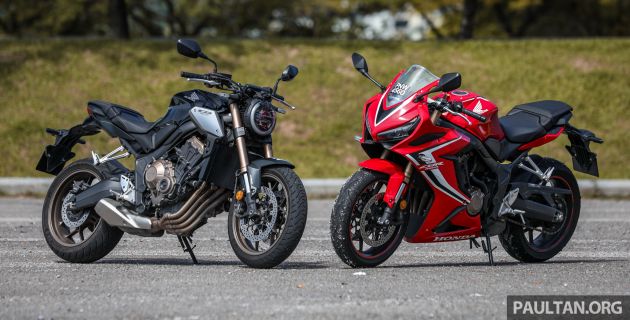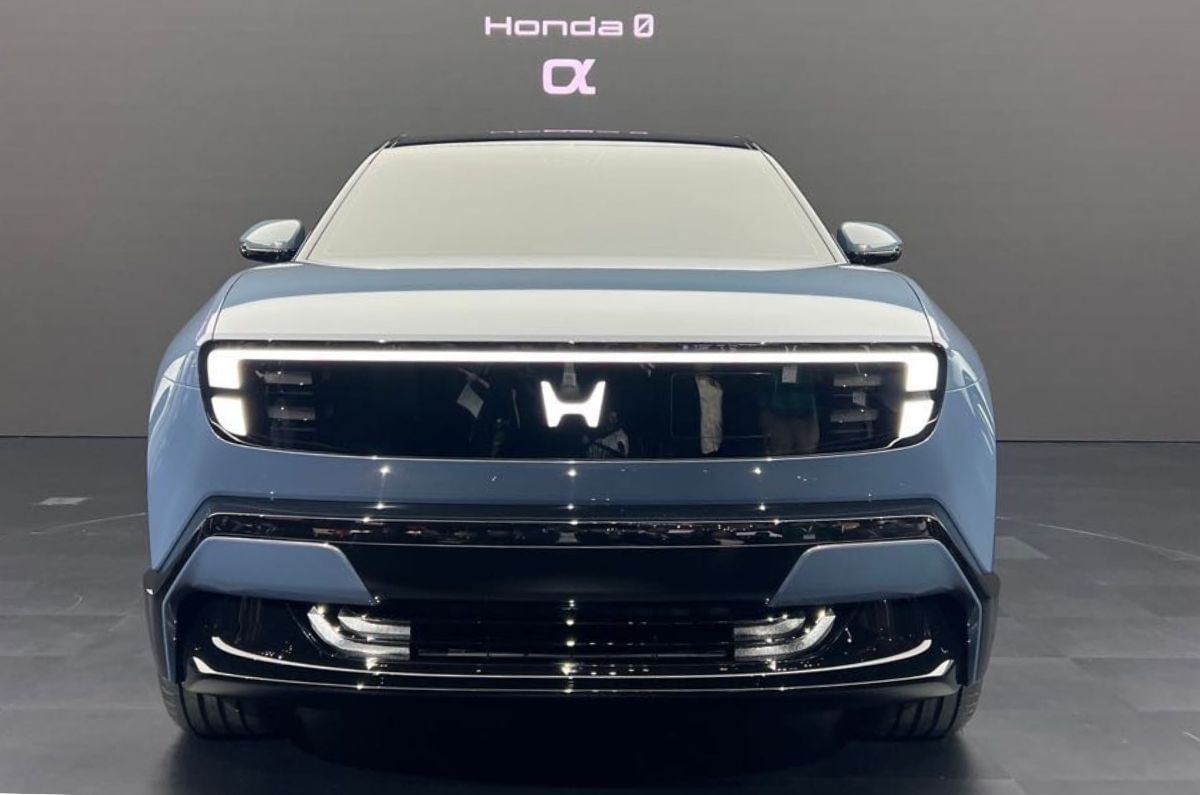REVIEW: 2019 Honda CBR650R and CB650R – inline-four middleweights for every rider, from RM43,999
Inline-fours, the iconic engine layout for what most people would call a ‘superbike’, have been with us for over forty years now. At one time, anything with four pots and overhead cams was a superbike, to be admired and respected, like the 2019 Honda CBR650R (RM45,499) and CB650R (RM43,499) on review with paultan.org.
But with advances in material and engineering technology, it is easy enough to get enough power from two- or three-cylinders, with the associated weight savings and handling benefits. After all, if your engine configuration is not as wide as a five-barred gate, the bike becomes nimble and easy to handle.
However, there is something about the silky smoothness of an inline-four mill dropped into a motorcycle frame. The author cut his teeth on one and truth be told, the engine layout missing from his personal stable is an inline-four since the sad demise of his Honda CB750K.
Lots of Vees, in two- and four-cylinder format, a couple of triples, some singles. But no inline-four with the closest the trigger came to being pulled was for the BMW Motorrad S1000RR last year.
So, to redress the situation, Boon Siew Honda, after letting us have the pair of CBR1000RRs, let us ride the CBR650R and CB650R for an extended period. Here’s what we thought about Honda’s four-cylinder middleweights.
paultan.org had previously sampled the CB650F during the RM50k bike shootout where the Honda’s middleweight 650 was put up against the Yamaha MT-09, Kawasaki Z900 and Triumph 765S, all of which, at the time, were available at a recommended retail of below RM50,000. That the previous model CB650F felt dated was readily apparent.
Things have changed with the CB650R and CBR650R though. Styling is bang up to date, LED lighting abounds and the CBR650R mimicking the looks of the CBR1000RR, in body style and graphics, makes it very attractive.
Getting the numbers out of the way, both the Honda 650s put out 93.8 hp at 12,000 rpm and 64 Nm of torque at 8,500 rpm. For riders of pure superports machines, these might seem a little tame but these the author feels is a good, middle of the road, power figure. Honda’s PGM-Fi does the fuel metering and a six-speed gearbox and assist and slipper clutch gets the ponies to the road.



So far, so good, the CB and CBR tick the correct boxes for what is a middleweight sports bike, with or without clothing. Seat height is a very approachable 810 mm, making the pair suitable for a wide range of riders though taller riders might feel a little cramped inside the CBR650R.
At the first approach, the styling for the CB650R follows the CB1000R Neo Sports Cafe very closely. This styling is also reflected in the CB250R and truth be told, we like it.
It conveys a very functional message to the rider, saying the CB650R is all about the business of riding a motorcycle and no nonsense. In practice, as we swung a leg over the CB650R’s saddle, we found the bike to be a good fit and motorcycling at its very basic.



This is not a fault, while many manufacturers – both two- and four-wheeled – seem to be on a unending quest to load their products down with bells and whistles, the CB650R goes the other and keeps things simple. Inside the cockpit, the LCD instrument panel shows everything the rider needs to know.
However, the LCD display is a monochrome unit, with white numerals on a blackground. We did have issues reading the panel in bright sunlight and more especially when using a tinted polarized visor.
The fuel gauge bar display itself is minuscule and as for the odometer readout, no chance. So, for us ‘senior’ riders who might be on the CB650R and CBR650R, don’t forget your bifocals.
Riding the CB650R around, we noted the engine was very eager to pull through the gears, rapidly reaching highway speeds and above, with few issues. The mill did run out of puff at the very top in sixth gear, limiting what its potential top speed might be and we have our suspicions there might be more to be gotten out of the 650 engine.
Needless to say, used as a daily runabout, the CB650R performed well, once we got used to the rather soft power delivery. Much, much better than the previous generation CB650F but still there was that niggling feeling this engine is capable of a whole lot more.
Since, in many cases, we test bikes in stock form or if we’re very lucky with a performance exhaust fitted – track and race bikes excluded – we think Honda has deliberately made the pair of 650s more road oriented and for the rider less concerned with pure speed as opposed to all round performance.
This is borne out by the mileage we got from the 15.4-litre tank, which was almost at 250 cc level. We didn’t keep any accurate figures but something like six or so litres per 100 km would not surprise us because both 650s went a long way between fill-ups.
With no wind protection, the CB650R is obviously going to give the rider a hard time with wind blast, especially with the throttle wound wide open. Something from the aftermarket will definitely be needed if the CB650R is going to be pressed into daily commuting service, including boxes, all of which are available from local suppliers like Givi.
Coming to the CBR650R, we earlier mentioned the family resemblance to its bigger sibling, the CBR1000RR. Looks aside, the CBR650R carries the same engine and frame as the CB650R and we expected performance to be about the same give or take a little allowing for the weight difference, the CBR650R being 207 kg and 5 kg heavier.


In on road riding, there was a noticeable lag in power delivery for the CBR650R, with the CB650R being much more eager in throttle response. We have no idea if this might be down to mapping or something else inside the ECU since neither bike has selectable ride modes, only traction control.
But for handling manners, the CBR650R had no vices, mainly because cut and thrust riding is not its forte despite the looks. For real sports bike handling, you’re going to have to look at the CBR600RR and the like, which is very much a track weapon but makes few concessions for street riding.
In this case, what the CBR650R is, and more so the CB650R, is a motorcycle designed for easy handling manners and road-going comfort. This is done with the Showa SFF upside-down 41 mm front forks, non-adjustable with compression and rebound in separate legs and the rear monoshock with 10-step preload adjustment.



This lack of adjustability reflects the mid-range pricing of the 650s and while not necessarily a fault, does mean the rider who is intended to purchase either bike wants something as fuss-free, reliable and simple as possible, something which Honda motorcycles are good at.
As stated earlier, both 650s are more than capable of breaking the speed limit, but at a less frenetic pace that what track heads are used to. But what exactly does this mean?
What it means is, the 650s are all rounders and despite its looks, the CBR650R is not a track weapon. In that respect, the brakes let it down, more so than on the CB650R.



Don’t get us wrong, with ABS and twin discs in front, the radial-mount Nissin four-piston callipers do a perfectly adequate job of slowing the bike down on the street but these are not racing brakes. A strong pressure was needed on the front brake lever if you’re a proponent of single-finger braking (like the author) with best results coming using the entire hand.
At no time was there a danger of flipping the bike over, Honda having designed the brakes to be linear and predictable. Again, something done to make the CBR650R and CB650R accessible to any level of rider.
This is also reflected in the choice of OEM rubber, Dunlop Sportmax for the CBR650R and Mezteler Roadtec 01 for the CB650R. Both tyre choices fit well with the character of the bikes and in the case of the CB650R, the Roadtecs did sterling service on the road, giving a lot of confidence and feedback.
The pairing of the tyres and suspension was, for the author, well matched, showing that Honda did put some thought into who would be riding these bikes and how. As it is, when ridden inside the envelope at highway speeds, there was nothing that would unduly upset the rider, newbie or otherwise.
Taken to the edge, of course, the tyres would rapidly demonstrate discomfort, leading to a rapid loss of traction on the front wheel for the CB650R, the rear for the CBR650R. Since most riders will never do what the author does when reviewing motorcycles, suffice it to say there is more than enough grip and suspension performance here for 90% of riders and if you’re one of the 10%, Honda did not design this bike for you.
For comfort, the riding position of the CBR650R, despite the full-fairing and clip-ons, is not as extreme as a pure sports bike, with enough room in the sear and handlebar rise for a rider to make themselves comfortable though those long of leg will have problems. The upright seating position of the CB650R means getting a cosy perch is a no-brainer with the wide bars allowing for full control of the bike.
So, who needs a Honda middleweight, either a naked sports like the CB650R, or a sports bike like the CBR650R? For riders trying to decide between the two, it comes down to a matter of looks as both are primarily street bikes and the only question that needs to be answered is, “what colour preference does sir have?”
In the market, competition comes from the Kawasaki Z650 and Ninja 650, priced at RM35,609 and RM37,189 respectively, although these two are parallel-twins and only produce 68 hp. Perhaps this is not a fair comparison, which leads us to look at the Triumph 765 S, priced at RM49,900 and the Yamaha MT-09 at RM47,388 but these are triples producing above 100 hp and there is no full-fairing version sold locally while the Yamaha MT-07 at RM38,388, two-cylinders and 73.7 hp is in the same class as the Z650.
If, like the author, you find the smooth revving of an inline-four motorcycle addictive and are on something of a budget, the Honda CBR650R with full-fairing and the naked sports CB650R are perhaps the only game in town. When pushed to make a choice by some riding buddies, the author’s hand was placed, quite deliberately, on the CB650R.
GALLERY: 2020 Honda CB650R 






































GALLERY: 2020 Honda CBR650R 










































The post REVIEW: 2019 Honda CBR650R and CB650R – inline-four middleweights for every rider, from RM43,999 appeared first on Paul Tan's Automotive News.
from Paul Tan's Automotive News
Read The Rest:paultan...











Post a Comment